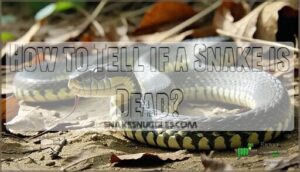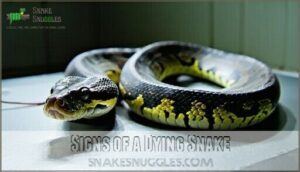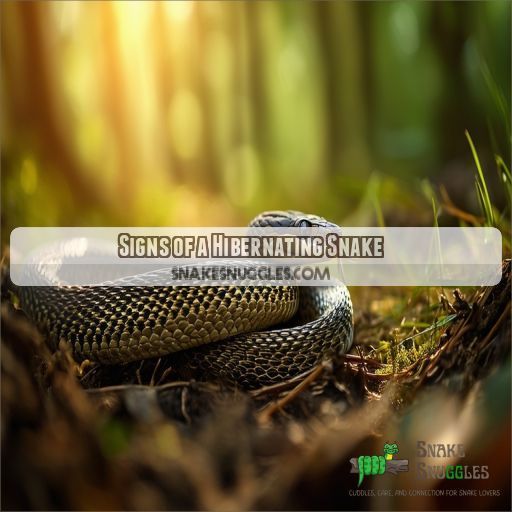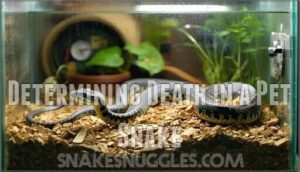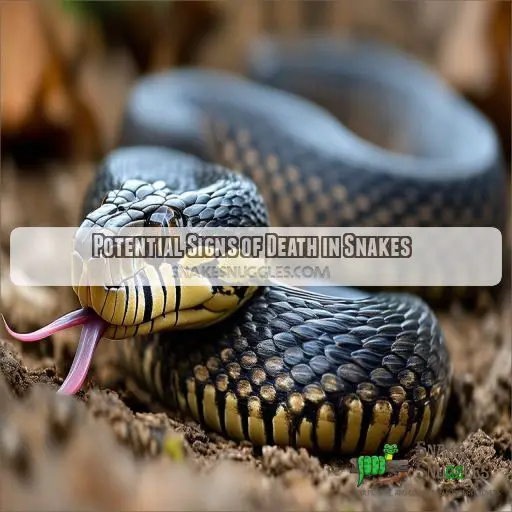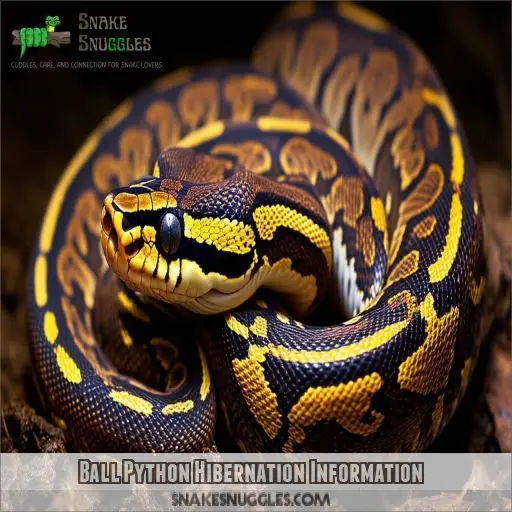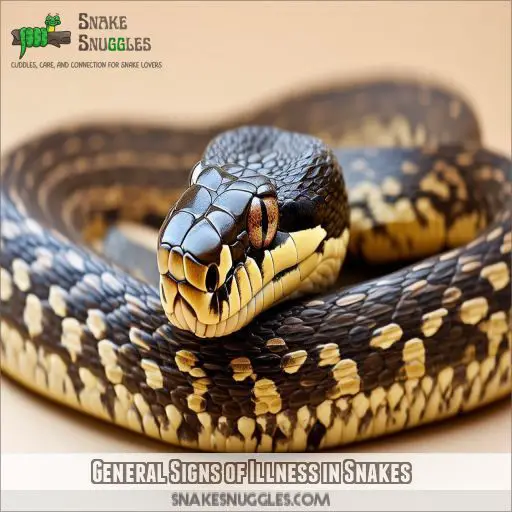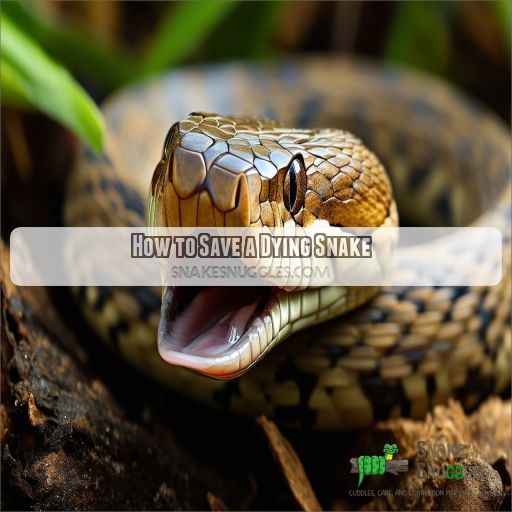This site is supported by our readers. We may earn a commission, at no cost to you, if you purchase through links.
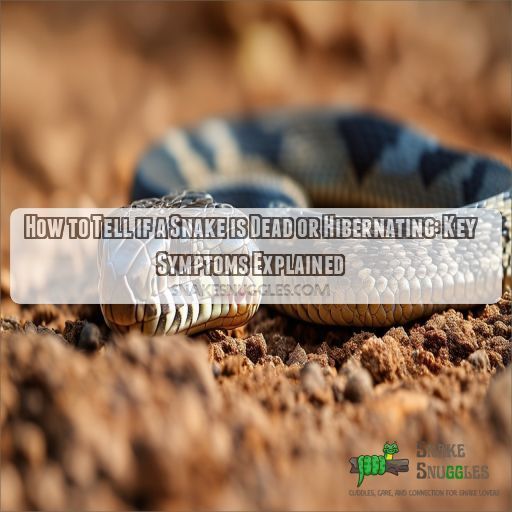
Knowing the significant symptoms is vital for peace of mind and your pet. This guide explains how you can know if a snake is dead or brumation by detailing the signs of a dying snake and symptoms of hibernation and their distinctions.
You will now be able to get clear, concise information to form a well-decided opinion about the condition of your scaly friend.
Table Of Contents
- Key Takeaways
- How to Tell if a Snake is Dead?
- Signs of a Dying Snake
- Signs of a Hibernating Snake
- Determining Death in a Pet Snake
- Signs of Hibernation in Snakes
- Potential Signs of Death in Snakes
- Ball Python Hibernation Information
- General Signs of Illness in Snakes
- How to Save a Dying Snake
- When to Seek Veterinary Care
- Frequently Asked Questions (FAQs)
- Is my snake dead or just not moving?
- How do you know if a snake is dying?
- How long does it take for a dead snake to stop moving?
- Why is my snake stiff and not moving?
- How long do snakes live in captivity?
- What is a snakes average lifespan?
- How often should a snake be fed?
- What temperatures are optimal for keeping snakes?
- Can snakes recognize their owners?
- Conclusion
Key Takeaways
- If your snake’s stiffer than a board or floppier than a wet noodle, it might be time to worry. A healthy snake should have some muscle tone and react to gentle prodding – no playing possum allowed!
- Keep an eye on those peepers! A snake’s pupils should react to light like a cat’s on catnip. If they’re as unresponsive as a teenager on a Monday morning, it could be a sign your scaly friend has slithered off to the great beyond.
- Don’t jump to conclusions if your snake’s doing its best statue impression. Hibernation can look an awful lot like the eternal nap, but a warm soak might just wake your reptilian Rip Van Winkle from its winter slumber.
- When in doubt, don’t be a snake oil salesman – get thee to a vet! These cold-blooded critters can be trickier to read than a book in Parseltongue, so a professional opinion is worth its weight in mouse-flavored gold.
How to Tell if a Snake is Dead?
Then, check for telling evidence if a snake is dead. In this case, the dead snake will not move or respond to stimuli, and its body is limp or has no muscle tone. You will further observe that it will not have noticeable breathing and that the pupils are not reactive to light. Further on, rigor mortis occurs, meaning stiffness of the body sets in.
Contrarily, the hibernating snake may occasionally move and have regular muscle tone. If uncertain, you can slightly warm the snake – if it’s alive, it will react sooner or later.
Note that snakes can appear dead even if they are alive, so they should be checked carefully. Other symptoms can be looked into more closely to decide whether your scaly friend is really dead or simply hibernating or sick.
Signs of a Dying Snake
If your snake is unresponsive to touch or movement, and you don’t see any visible signs of breathing, it could be a sign that your snake is dying. Look for a lack of muscle tone and dilated, unresponsive pupils – these are also potential indicators that your snake may no longer be with us.
Lack of Responsiveness
If your snake shows a lack of movement, doesn’t respond to gentle touch, and exhibits a lack of muscle tone, it could be a sign it’s dying. Look for no reaction to eye stimulation or feeding, as well as general lethargy. Be cautious: some snakes might be playing dead, so these signs should prompt further investigation.
No Visible Breathing
If your snake shows no visible breathing, it could be a sign of respiratory distress or more severe problems. Watch closely for signs of breathing difficulties.
Ball pythons in particular may suffer from respiratory issues.
Check for subtle movement in the ribcage or nostrils. Breathing problems can indicate serious health issues or, in the worst case, suggest the snake may be dead.
Muscle Limpness
Muscle limpness is a significant sign something’s wrong. If your snake shows complete loss of muscle tone and feels unusually floppy, it may be a serious indication of death.
Check the body temperature and look for other signs like dehydration. Typically, a healthy snake will resist handling if it feels threatened. Limpness shows an alarming lack of responsiveness, needing immediate attention.
Pupils Unresponsive to Light
Checking your snake’s pupils helps determine if it’s dead or hibernating. Dead snakes often have unresponsive pupils. To test:
- Shine a light gently in each eye.
- Note if the pupils stay the same size.
- Observe any lack of pupil dilation.
- Check for absence of the corneal reflex.
Unresponsive pupils indicate potential death.
Lack of Reaction to Stimulation
If the snake doesn’t respond to a light touch or to sensory stimulation, it may indicate the absence of activity in the brain, nerves, or reflex response. A dying snake won’t even respond to gentle prodding or fluctuating environmental changes.
It’s imperative to consult a snake vet to get proper snake care and have snake symptoms diagnosed, whether they are snake diseases or skin problems.
Signs of a Hibernating Snake
If your snake shows occasional movement and reacts to touch, it’s likely hibernating rather than dead. Be sure there are no signs like stiffness, color change, or fluid discharge from the nostrils, mouth, or vent.
Occasional Movement
Occasional movement is a telltale sign that your snake is hibernating rather than dead. During hibernation, they may wiggle slightly in response to touch, reflecting natural hibernation duration and isolation behavior.
- Recovery strategies post-hibernation include gradual warming.
- Monitor seasonal patterns and adjust habitat suitability.
- Watch for subtle changes like weight loss and skin coloration.
No Stiffness or Color Change
Unlike a deceased snake, a hibernating snake won’t have any stiffness or color changes. This is because the cooler habitat temperatures trigger their hibernation response, slowing their metabolism and bodily functions. As long as the habitat stays within the proper temperature range, you shouldn’t see any concerning rigidity or pigment shifts in your hibernating snake.
No Fluids From Nostrils, Mouth, or Vent
One won’t notice fluids coming out of the nostrils, mouth, or vent of a hibernating snake. There should be no mucous discharge or respiratory distress in the snake. Dry nostrils would mean its airways aren’t blocked. Check for the following:
• No mucous discharge
- Dry nostrils
- Absence of fluids from mouth or vent
- No respiratory distress
Eyes Not Sunken
If your snake’s eyes aren’t sunken, that’s a good sign it’s hibernating. Healthy eyes should maintain clarity, normal shape, and size, without appearing dry or shrunken. Look for natural eye movement or reaction to light. If the eyes remain vibrant and retain their color, your snake is likely just in a dormant state rather than deceased.
Normal Muscle Tone
In a hibernating snake, normal muscle tone remains intact, unlike the limpness seen in a deceased one. You’ll notice the snake’s limbs are flexible, showing no signs of rigor mortis. Additionally, the snake’s body temperature might be cool but not cold to the touch. If there’s slight reflex response when touched, hibernation is likely the cause.
Determining Death in a Pet Snake
You can tell a dead pet snake if it’s stiff or flaccid; the latter happens upon death, and also if it does respond to a warm soak. On the other hand, proper temperature in its habitat should be ensured since a cold one may indicate hibernation, not death.
Stiffness
While examining your snake, stiffness can indicate death. If you find your pet rigid with no flexibility in the body, this might be due to rigor mortis, a clear postmortem sign. This stiffness typically appears several hours after death and can last for days, leading to decomposition. Always check for rigor mortis carefully to confirm.
Flaccidity
If your snake’s body is flaccid, with soft skin and pliable limbs, it may be dead. Relaxed muscles and a lack of firmness often indicate death. Gently handle your snake; if it feels unusually limp without any muscle tone, this is a sign to be concerned. Remember, flaccidity is a key sign, so observe carefully.
Habitat Temperature Check
You must check on the temp of your snake’s habitat. Ensure it’s at room temperature. The optimal temperature should be above 85°F. Temperature fluctuations can create hibernation or worse. Your snake may be in its hibernation cycle if your habitat has been too excellent. Cooling methods aren’t adequate, and you should never use them like ice packs.
Response to Warm Soak Test
Now, conduct a warm soak test. Gently put your snake in lukewarm water for about 15-30 minutes. This is to check whether the animal is hibernating or dead. Observe for:
- Movement: twitching or squirming is a sign of life.
- Temperature Gradient: Warmth should stimulate activity.
- Post-soak behavior: Note that the breathing and locomotion of the snake return to normal.
Proper handling is very essential during soaking.
Signs of Hibernation in Snakes
In hibernation, a snake often curls up into a ball and shows little to no movement. If the habitat temperature is below 85°F and the snake remains inactive even after a warm soak, it might be hibernating rather than dead.
Curled Up in a Ball
When a snake is curled up in a ball, it could be a sign of hibernation rather than death. During hibernation, snakes often seek warmth by curling tightly into a small or large ball, depending on their size. This behavior helps conserve heat and energy. Always check the habitat temperature, as cooler environments promote hibernation, not death.
Inactivity
Inactivity in a snake can be a key sign of hibernation. Along with being curled in a ball, you’ll notice:
- Minimal movement despite environmental changes.
- Lack of response to typical stimuli like handling or food.
- Body language may seem relaxed, not rigor mortis-like, indicating hibernation rather than death.
These signs reflect normal social behavior and survival adaptation.
Habitat Temperature Below 85°F
Monitor temperature; ideally, it shouldn’t fall below 85°F. If it’s more relaxed, that can trigger hibernation and result in being inactive. Use an excellent thermometer to maintain proper heat source levels. Prolonged exposure to low temperatures will start taking its toll on the snake and slowly begin to compromise your snake’s health, so maintain the proper temperature.
| Temperature | Activity Level | Indicator |
|---|---|---|
| < 85°F | Low | Likely hibernation |
| 85-90°F | Moderate | Normal behavior expected |
| < 60°F | Very Low | Lethargy or worse potential |
| 60-85°F | Variable | Possibly sluggish metabolism |
| > 90 °F | High | Potential for stress or overheating |
Post-Warm Soak Activities
If your pet snake becomes agitated after a warm soak, it’s hibernating. The movement and checking for muscle tone also give an indication. The temperature in the habitat should be above 85°F to avoid digestive problems. If he remains inactive and non-responsive, seek a reptile vet immediately. Proper care ensures your snake stays healthy and safe.
Potential Signs of Death in Snakes
Check whether your snake might be dead by the following signs. First, the flaccidity—he is limp and has no muscle tone in his body.
Next, a kind of abnormal smell, like the one just pooped out, and this smell is related to decomposition.
His tongue: no flicking of tongues for more than one week is suspicious. Moreover, if it hasn’t pooped for over two weeks, that might be a sure sign of severe sickness or possibly death.
Lastly, the stalking or the rigor mortis is the most definite indication. When the snake doesn’t respond to touch or movement and shows these signs, it’s likely dead. Always consult a vet for confirmation.
Ball Python Hibernation Information
Ball pythons are known to hibernate when temperatures drop below 85°F. During this time, their digestive system may slow down, leading to potential issues if not properly cared for. Be sure to monitor your snake’s habitat temperature and watch for any signs of distress or illness.
Hibernation Temperature
For ball pythons, the critical temperature range for hibernation is below 85°F. It acts as a hibernation trigger. Watch out for these key points:
- Long-term effects: Prolonged low temperatures can harm your snake.
- Potential risks: Hypothermia and respiratory issues can develop.
- Recovery time: Gradually warm the enclosure to help your snake revive safely.
Potential Digestive Issues
During hibernation, digestive issues can arise in your snake. If the temperature drops too low, food may rot in its stomach, leading to gastric upset and bloating. Keeping the habitat above 85°F can prevent these problems. Watch for signs like distended abdomen and lack of appetite, which indicate gut health issues that need immediate attention.
Proper Disposal Protocols
If the snake doesn’t respond to treatment and appears lifeless, it’s important to know how to properly dispose of it. Consider the following methods:
- Burial Methods: Let it be deep enough not to be disturbed.
- Composting Options: This can be eco-friendly, but it does require some research.
- Cremation Services: Many vets will provide this service.
- Memorialization Rituals: It’s a way to personalize the good-bye.
- Consult Regulations: Understand the local laws, and follow the same for pet disposal.
General Signs of Illness in Snakes
One should be in a position to recognize general signs of illness among snakes. Keep your snake pet in good health and skin conditions; watch out for other symptoms like loss of appetite or other abnormal behaviors. Follow up with a veterinarian if your snake looks distressed in any way.
Skin Problems
Watch for skin changes like rashes or blisters. They can signal health issues. Shedding problems, noticeable lumps, or sores are red flags. If you notice skin darkening, flaking, or discoloration, don’t ignore it. These could indicate infections or parasites. Snakes rely on their skin for protection, so any abnormality warrants immediate attention.
Additional Symptoms and Care
Watch your snakes for general signs of illness:
- Behavioural Changes: Restlessness or lethargy.
- Loss of Appetite: Refusal to take food for a long period.
- Respiratory Distress: Wheezing, open-mouth breathing.
- Neurological Symptoms: Tremors, incoordination.
If you start to see these signs, immediate professional help from a veterinarian is required for the treatment of potential health conditions to ensure your snake’s well-being.
How to Save a Dying Snake
If you think your snake is dying, immediate veterinary care is crucial. Follow reptile care guidelines to maintain proper habitat conditions and monitor the snake closely.
Seek Veterinary Care
If you have any concerns over your snake’s health, then you should contact a reptile vet. Be careful with your snake during hibernation, and know that cold temperatures make them less responsive. Prolongations in activity may mean serious health issues, where you must consult a vet for professional advice in order to get life-saving treatment.
| Action | Importance | Consideration |
|---|---|---|
| Handling | High | Gentle touch |
| Consult Vet | Critical | Expert advice |
| Monitor Temp | Vital | Affects behavior |
Follow Reptile Care Guidelines
Be sure to follow proper care instructions for your snake regarding dietary needs and housing set-ups.
Ensure that temperature and humidity are monitored regularly, and handle the snake gently to minimize undue stress. Proper socialization or handling will avoid most problems.
Sudden changes in environment or diet are what you duly have to avoid since one of the keys to good health for your snake is consistency.
When to Seek Veterinary Care
When one feels that their pet snake is either hibernating or dead, it’s essential to have the animal delivered to a veterinarian. You can call locally around to find a vet experienced in reptiles, or if you’re in a more dire situation, an emergency clinic will suffice.
Local Reptile Veterinarian
When your snake is demonstrating the most critical signs of being sick or even dying, it’s of paramount importance to find a local reptile vet. Here are three steps in detail:
- Find a vet specializing in local reptile care.
- Describe the symptoms you’re experiencing.
- Be prepared to cover veterinary expenses, because specialized care could become very expensive.
Quick action on your part gives your snake the best chance for recovery.
Emergency Clinic Contact Information
This is important in establishing options for clinics that have reptile-specific services.
Ensure they have weekend availability and after-hours care because your snake may need urgent attention outside the typical hours.
After that, ensure that the clinic accepts your insurance coverage.
Knowing the locations of emergency clinics can be best attained through local directories and veterinary associations so that, in times of emergencies, you can provide your snake with the best possible care.
Frequently Asked Questions (FAQs)
Is my snake dead or just not moving?
Well, if it’s as limp as a rag, then your snake could very well be dead. Next, look out for no responsiveness to touch, no breathing visible, and dilated pupils. If you’re still not certain, a visit to the vet is necessary.
How do you know if a snake is dying?
Knowing when a snake is dying can be from its lethargy, unusual twitches, difficulty breathing, lack of muscle coordination, and lack of reaction to light. Taking immediate concern to veterinary care is essential to diagnose and probably save the snake.
How long does it take for a dead snake to stop moving?
A dead snake usually stops moving within a few minutes to hours due to loss of muscle control and rigor mortis. Look for unresponsiveness, stiff body, limpness, and eyes that don’t react to light.
Why is my snake stiff and not moving?
Your snake might be stiff and not moving due to rigor mortis, which typically sets in within a couple of hours after death. Check for lack of responsiveness, breathing, and muscle tone to confirm.
How long do snakes live in captivity?
The life expectancy of snakes in captivity may range from ten to thirty years, depending upon the species, habitat conditions, diet, and health care. Proper environment and regular veterinary care can prolong their age to a great extent.
What is a snakes average lifespan?
A regular snake will live from 10 to 20 years in captivity. Some species, such as ball pythons, can easily reach 30 years or more if they’re well cared for. Proper nutrition, a good environment, and regular visits to the vet can keep them going for long periods.
How often should a snake be fed?
Feed your snake every 1-2 weeks, depending on its age, size, and species. Younger snakes need more frequent meals, while adults can go longer between feedings. Always monitor its health to adjust feeding schedules accordingly.
What temperatures are optimal for keeping snakes?
Habitat temperatures must be kept between 75°F and 85°F, with slight variation depending on species, to create the best care for your snake. Thermometers will monitor this to provide a warm basking spot and a more relaxed area for thermoregulation.
Can snakes recognize their owners?
While snakes may seem cold-blooded, they’re not emotionless. You’ll find they can recognize their owners through scent and routine. They’ll often approach familiar people, showing comfort and curiosity. It’s a subtle but rewarding bond you’ll develop over time.
Conclusion
Every single pet owner should know how to tell if a snake is dead or hibernating. A proper understanding of signs associated with dying snakes and hibernation will enable an owner to make informed decisions about their reptile’s health.
Regular checks on the habitat and your snake, proper habitat maintenance, and timely action taken when needed will ensure your snake’s health.
With this knowledge, you’re better positioned to take good care of your scaly companion throughout its life.

